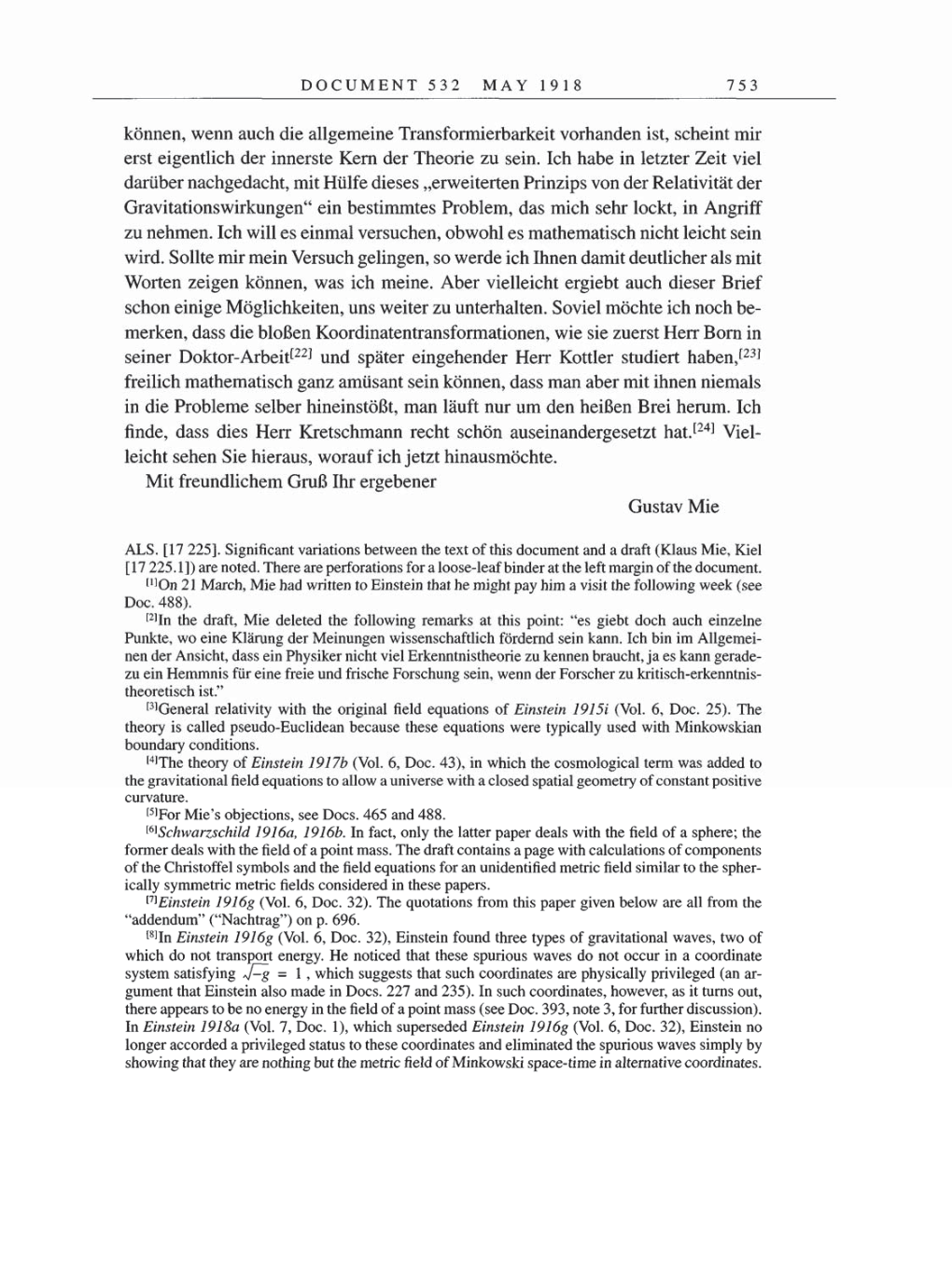DOCUMENT 532 MAY 1918 753
können,
wenn
auch die
allgemeine
Transformierbarkeit vorhanden
ist,
scheint mir
erst
eigentlich
der innerste Kern
der
Theorie
zu
sein. Ich habe in letzter
Zeit
viel
darüber
nachgedacht,
mit Hülfe dieses "erweiterten
Prinzips von
der Relativität der
Gravitationswirkungen"
ein bestimmtes
Problem,
das mich sehr
lockt,
in
Angriff
zu
nehmen. Ich will
es
einmal
versuchen,
obwohl
es
mathematisch nicht
leicht
sein
wird. Sollte mir mein Versuch
gelingen,
so
werde ich Ihnen damit deutlicher als mit
Worten
zeigen können,
was
ich meine.
Aber vielleicht
ergiebt
auch dieser
Brief
schon
einige Möglichkeiten,
uns
weiter
zu
unterhalten. Soviel
möchte ich noch
be-
merken,
dass die
bloßen
Koordinatentransformationen,
wie sie zuerst
Herr
Born in
seiner
Doktor-Arbeit[22]
und
später
eingehender
Herr Kottler
studiert
haben,[23]
freilich
mathematisch
ganz
amüsant sein
können,
dass
man
aber
mit ihnen
niemals
in die Probleme selber
hineinstößt,
man
läuft
nur um
den heißen Brei herum. Ich
finde,
dass dies Herr Kretschmann
recht
schön
auseinandergesetzt
hat.[24]
Viel-
leicht sehen Sie
hieraus,
worauf
ich
jetzt
hinausmöchte.
Mit freundlichem Gruß Ihr
ergebener
Gustav Mie
ALS.
[17 225].
Significant
variations
between
the
text
of
this document and
a
draft
(Klaus
Mie,
Kiel
[17 225.1])
are
noted. There
are perforations
for
a
loose-leaf
binder
at
the left
margin
of
the
document.
[1]On 21 March,
Mie had written
to
Einstein that he
might
pay
him
a
visit the
following
week
(see
Doc.
488).
[2]In
the
draft,
Mie deleted the
following
remarks
at
this
point:
"es
giebt
doch auch einzelne
Punkte,
wo
eine
Klärung
der
Meinungen
wissenschaftlich
fördernd sein kann. Ich bin im
Allgemei-
nen
der
Ansicht,
dass ein
Physiker
nicht viel Erkenntnistheorie
zu
kennen
braucht, ja
es
kann
gerade-
zu
ein Hemmnis
für
eine freie und frische
Forschung
sein,
wenn
der Forscher
zu
kritisch-erkenntnis-
theoretisch ist."
[3]General
relativity
with the
original
field
equations
of Einstein 1915i
(Vol. 6,
Doc.
25).
The
theory
is called
pseudo-Euclidean
because these
equations
were typically
used with
Minkowskian
boundary
conditions.
[4]The
theory
of
Einstein 1917b
(Vol. 6,
Doc.
43),
in which the
cosmological
term
was
added
to
the
gravitational
field
equations
to
allow
a
universe with
a
closed
spatial geometry
of
constant positive
curvature.
[5]For
Mie's
objections, see
Docs. 465 and 488.
[6]Schwarzschild
1916a,
1916b. In
fact,
only
the latter
paper
deals with the field
of
a sphere;
the
former deals with the field
of
a point mass.
The
draft
contains
a page
with calculations
of
components
of
the Christoffel
symbols
and the field
equations
for
an
unidentified metric field similar
to
the
spher-
ically symmetric
metric fields considered in these
papers.
[7]Einstein
1916g
(Vol. 6,
Doc.
32).
The
quotations
from
this
paper
given
below
are
all from the
"addendum"
("Nachtrag")
on p.
696.
[8]In
Einstein
1916g
(Vol. 6,
Doc.
32),
Einstein
found
three
types
of
gravitational
waves,
two
of
which do not
transport energy.
He noticed that these
spurious waves
do
not
occur
in
a
coordinate
system satisfying
f-g
=
1,
which
suggests
that such coordinates
are physically privileged (an ar-
gument
that Einstein also made in Docs. 227 and
235).
In such
coordinates, however,
as
it
turns out,
there
appears
to
be
no energy
in the field
of
a point mass (see
Doc.
393,
note 3,
for further
discussion).
In Einstein 1918a
(Vol.
7,
Doc.
1),
which
superseded
Einstein
1916g
(Vol.
6,
Doc.
32),
Einstein
no
longer
accorded
a
privileged
status
to these coordinates and eliminated the
spurious waves simply by
showing
that
they are nothing
but the metric field
of
Minkowski
space-time
in alternative coordinates.
